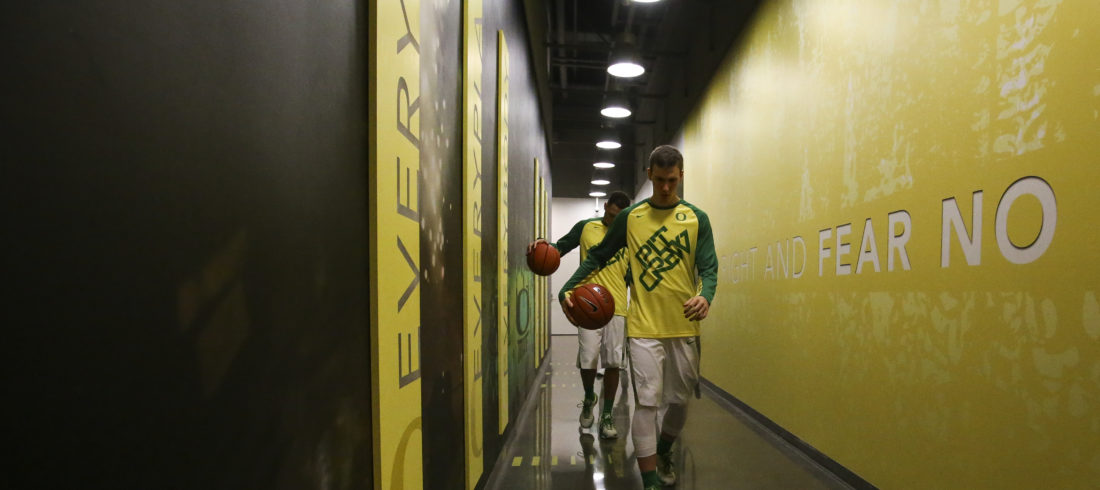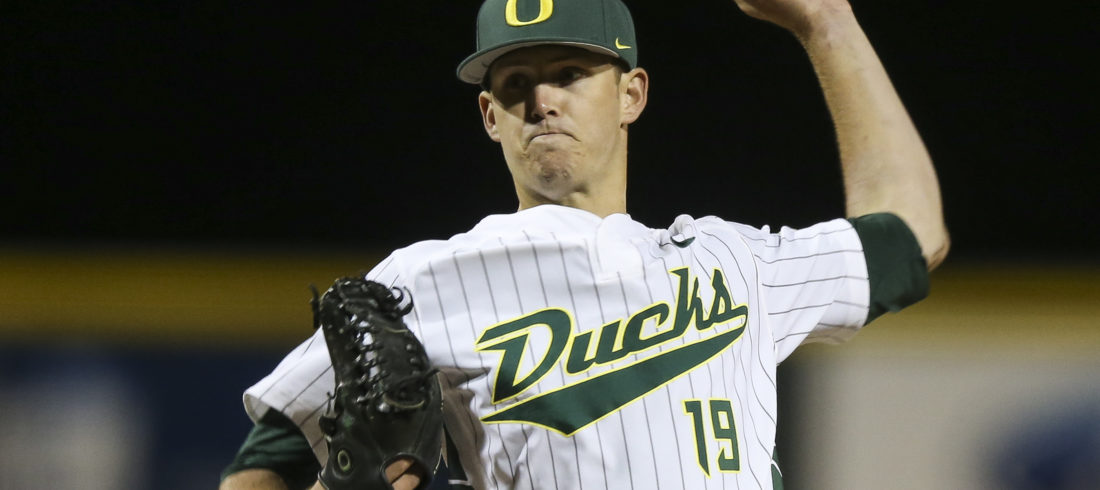Playing sports at the University of Oregon requires an athlete to be physically fit. Some athletes may require weight training to get stronger. Others may need to run more to get faster. Whatever the case, one thing is common for any athletic endeavor: In order for any Duck to perform better, they have to recover.
“Recovery is key,” says UO Sports Nutritionist Pratik Patel. “We’re asking our athletes to perform on a day-to-day basis for the majority of the year. Their bodies have to hold up so they’re ready for the next competition.”
And just like an athlete has to find the balance between too much training and too little, the same is true for the healing process.
“It should be looked at as a multi-dimensional continuum,” UO Sports Science Coordinator Hugh Fullagar explains. “You have too much recovery, you might not be able to perform at your best. Obviously, if you under recover, your performance can also be hampered. It’s all about getting a balance between fitness and fatigue.”
Such a complex undertaking requires more than one person in the Oregon athletic department to make that happen.
“Part of it comes from the strength and conditioning coaches, says Fullagar. “It also comes from the sports scientists like myself, the athletic trainers, and the nutritionists. It comes down to the performance team as a whole. They balance that need to get that performance and enhancement, but also to manage the fatigue afterwards to ensure that the subsequent performance is better and you’re always improving.”

What is required for athletes to improve varies on a case-by-case basis. Whether it’s a matter of a different sport or various goals, one size does not fit all.
“Some recovery methods might work better for some athletes, but not others,” explains Fullagar. “So we try to tailor the majority of our recovery strategies to each individual. We’ll do it whether they’re playing or not playing or whether they’re training over a certain threshold or not training enough. We’ll collect a range of data from a variety or sources that are aimed at either performance on the field of play or health and welfare off the field and reducing the risk of injuries.”
That being said, though recovery needs may be unique, the end goals are always the same.
“It’s all about benefitting the player and coaching staff in driving positive change or validating what you’re already doing,” Fullagar says. “Like (UO head football coach) Mark Helfrich is always saying, ‘Here at Oregon we’re in the business of getting better.'”
By the same token, the bulk of the healing after a practice or a game is pretty simple.
“Sleep and nutrition certainly comprise the large majority of recovery,” Fullagar explains. “But there are the little things we can do to improve that 1 to 10 percent extra where we try to tailor certain aspects.”
Let’s start with the nutritional side. Food is definitely fuel for the average Duck.
“Nutrition is an integral part of athletic performance,” says Patel. “It’s not the most important and it’s not the least important. You have different sizes of athletes on different teams. Even on the same type of team you have different players with different genetics and backgrounds playing the same position. So we don’t want to encompass the same size umbrella in terms of teaching them or suggesting the same things to eat and drink.”

Some athletes may need more protein and fewer carbohydrates. Others may need more carbs and vegetables. Whether it’s the special healthy snacks that can be picked up at the Casanova Center and other athletic areas, or the meals at the training table, the various competitors are covered by the nutritional team led by Patel.
“Pratik Patel does a good job keeping us on our toes with having our bodies where they have to be,” says UO baseball pitcher Cole Irvin. “We always get the food we need.”
Part of that not only entails being fed between meals and classes but during games themselves. For example, some baseball players will eat protein bars every two to three innings to sustain energy and stay full.
“We try to provide them with items to sustain their energy levels during games,” Patel says. “We want to keep their blood and glucose levels steady. It’s not about providing them with a certain amount of calories. It’s about giving them the right foods and fluids especially during games that might be longer than others. We’re also there after the games to assure they’re getting fluids and fed the right way to recover.”
That’s also where the sports science department led by Fullagar comes in. The demands of a student athlete are great, whether it’s academic or sports-related. As a result, there’s little time for any athlete to know how to physically heal properly without guidance.
“Much of the stuff we try to do is provide an environment from a recovery perspective that motivates the athlete to be better,” Fullagar says. “Again, 80-to-90 percent is just sleep and nutrition (as opposed to fancy technologies which are cool) and we focus on getting those done correctly. But some need another 1 to 10 percent extra.”
What those extra percentages are depend on the athlete.
“Some athletes might prefer compression,” says Fullagar. “Others might prefer cold-water immersion or contrast-water immersion. But others might want to use a variety of technologies we have available. We try to educate our athletes on the benefits certain things offer and the benefits they can have and try to figure out what’s best for them.”
Cold-water immersion or “ice baths” seem to be a popular choice for some Ducks.
“It just helps my legs,” says UO men’s basketball guard Casey Benson. “They recover quicker and get the wear and tear out.”
“I feel like I can run like right away after I do this,” claims UO women’s basketball guard Lexi Bando about immersion. “It really helps me come out the next day and move at practice.”
It is actually an option that has plenty of merit.
“There’s a logical reasoning with cold water and compression,” Fullagar says. “It theoretically decreases inflammation in the working muscles. So when you work or exercise, you’ll have pro-inflammatory cytokines that will circulate the bloodstream, such as creatine kinase, and cause the muscles to be sore. The idea is by decreasing that inflammation after a hard performance, the cold water can actually reduce that soreness.”
Another way some Ducks heal after a long event is through massage.
“I try to get up early and work with the trainers to get massaged and be ready for the next game,” explains UO baseball outfielder Phil Craig-St. Louis. “It tends to reduce my soreness.”
But as discussed with other stuff here, massage isn’t necessarily for everyone.
“Massage depends on the individual,” says Fullagar. “The evidence for that as a form of recovery is pretty mixed. There’s no hard evidence after hard exercise to say it can benefit the next performance unless the athlete perceives it to be important. If a player wants it the day after a game, we offer it.”
What is also offered, to great acclaim, is yoga. Not only does it do a lot for the body, but also the mind.
“I do yoga before my starts,” Irvin says. “It’s a fun way to stay loose.”
“I’ve used it since I’ve put on a little more muscle,” says Craig-St. Louis. “Yoga just kind of brings back more flexibility.”
“We do yoga once a week as a team,” says Bando. “I personally love that because it gets your mind right as well. It’s not just about the body and stretching. It clears your head up, too.”
Fullagar concurs that yoga can be very beneficial if done correctly.
“Yoga can improve mobility and flexibility if it’s done on a regular basis,” Fullagar explains it by keeping in the mind the fact that this situation arises. “Theoretically, that can reduce the risk of injury and can become more resilient for movement in sports like football. In terms of recovery after a training session or a game, I’d say a lot of yoga would be mental relaxation. But you’d also have the physical benefits of it. Again, the research is mixed. But if the player buys into it, then it would most definitely improve the psychological recovery after an event. That can be just as important as the physical and sometimes that’s overlooked.”
Going forward, the ability for UO athletes to reach optimal performance through recovery should even improve further with the Marcus Mariota Sports Performance Complex opening this September. It will include (among many other things) equipment using 3D motion capture technology to measure ranges of motion and detect possible inefficiencies. That’ll certainly give Fullagar many more ways to get the most out of his Ducks.
“You’re always collecting a range of physical and psychological data in sports science,” he says. “That’s on and off the field. We definitely have access to a range of resources that other organizations wouldn’t have and that’s why people assume we’re one of the best. But I’d say we have great people from the coaches down to the performance team and we’re always reevaluating.”
Regardless, he believes that one thing determines success in the end.
“Our success is based on whether the player in your environment is happy and they are enjoying what they’re doing. If the player’s not happy, then it’s going to be very tough to motivate them to get healthy or smarter and become a better overall player. Ultimately, everything we do is about the

